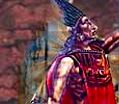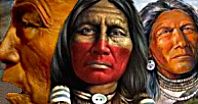|
|  |

HOHOKAM ANCIENT INDIAN CIVILIZATION

Hunting and gathering practices of the Hohokam
AUTHOR: Linda M. Gregonis & Karl J. Reinhard
The Tucson Basin Hohokam constantly supplemented their agricultural diet with native foods. In drought years, the Indians depended heavily on wild plants and animals.
The Hohokam collected mesquite beans from the trees that grew along the river banks. Villagers stored the bean pods in baskets and jars or mashed them into flour, using a mortar and pestle. This important resource could have been made into broths, stews, and breads.
The villagers also collected foods in the desert foothills, as do the Pimas and Papagos today.
In June, July, and August, they gathered fruits of the saguaro, cholla, prickly pear, and barrel cactus. When collecting cactus fruits then, as now, groups of people camped in the cactus groves. They ate, dried, and cooked the plants at the camps.
The Hohokam probably prepared cactus in much the same way as the Pimas and Papagos do. After removing the needles, cholla buds and prickly pear pads were baked slowly in pits. Cholla buds were also boiled.
The Hohokam cooked down saguaro fruit into syrup and made cakes from the dried seed. They probably made wine from the syrup.
Other cactus fruits that were not eaten raw were dried and stored. The Hohokams returned to their villages only with those products that were to be saved for later use.
The Hohokam went on gathering expeditions to the mountains. There, they harvested agave crowns, acorns, manzanita berries, and other small fruits. The Indians roasted the agave crowns in pits to make a succulent meal. Berries and acorns collected in the mountains may have been used later as additives in otherwise bland stews and breads.
The Hohokam supplemented their primarily plant-food diet with meat. They had no domestic animals except the dog, so most meat was obtained by hunting. Deer and rabbit were the most important meat sources, but the Indians also killed and ate mountain sheep, antelope, and rodents, including mice and ground squirrels.
Dove, quail, duck, and geese were among the birds hunted, and Indians who lived along larger rivers also ate fish. Not particular in their culinary habits, the Hohokam also added tortoises, lizards, and snakes to their diet.
Villagers hunted larger animals with bows and arrows. Birds, mice, lizards, and snakes could have been trapped or shot with arrows. During certain seasons, Indians conducted communal rabbit hunts. They drove rabbits and other small animals into nets strung across drainages.
Hohokam Rabbit Hunt
Groups of people, walking slowly in a line towards the net, beat the bushes and shouted, to crowd the animals before them. Such a drive could have yielded enough food for a whole village during the late winter starvation time, when little of the stored plant foods remained.
Preparation of an animal for eating depended on the size and type of creature killed. Small animals, such as lizards, mice, and ground squirrels, could be eaten raw or could be spitted and cooked without gutting.
The Hohokams skinned and gutted larger animals at the site of the kill, using sharp flakes of rock as knives. In a few seconds, the sharp fragments were knocked from a larger rock and were ready to use. When one flake became dull, it was discarded and another was made.
After returning to the village, meat was portioned for roasting by using heavy stone choppers to cut joints and tendons. The meat could also be cut into strips with knife-like flakes and dried in the sun.
Native plants and animals were not used solely for food by the Hohokam. Materials for houses, ramadas, clothing, containers, ritual paraphernalia, and tools also came from the rivers, deserts, and mountains.
The Hohokam were completely dependent on their immediate environment for all the necessities of life.
SOURCE:
Excerpted from the book, 'Hohokam Indians of the Tucson Basin' by Linda M. Gregonis & Karl J. Reinhard.
Copyright © 1979.The Arizona Board of Regents
RELATED ARTICLES:
Predecesors of the Hohokam Indians
The Hohokam Indians of the Tucson Basin
Hunting and Gathering Practices of the Hohokam
Clothing and footwear of the Hohokam
Discovery of Hohokam ruins surprises archaeologists
|
 |


|
|
| | | | | | | | |
 |
|
|

